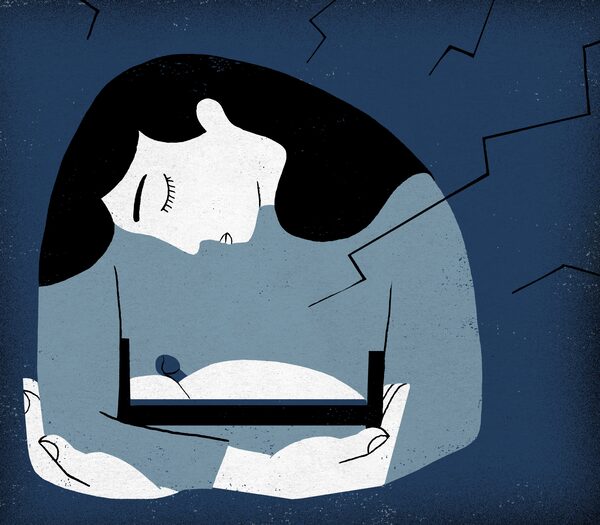
Illustration by Hanna Barczyk
At the height of the lockdown in Ottawa, Donna Thomson and her husband, Jim, went to visit their 32-year-old son Nicholas, who has severe cerebral palsy and lives in a care home. Like many families with disabled children who live in group settings, they’d been unable to see him for a long time. But it was not a happy experience.
They stood outside Nicholas’s window, trying to interact with him. “It made me really sad,” says Ms. Thomson over the phone. “They have triple-glazed windows and all I could see was my reflection. When you’re speaking to a non-speaking person, so much communication is non-verbal, through body language. I just felt so far away from him.”
Ms. Thomson is quick to point out that Nicholas is fortunate: He receives wonderful care, and his home actually had a pandemic plan. But, as an advocate for caregivers, what she sees around her right now is distressing. Caregivers are struggling to cope, whether they’re tending to loved ones at home, or are living separately and unable to see them.
“The burden of care has skyrocketed, and there’s no support and no mental-health support,” she says. “People are struggling alone with the full burden of care, and watching their loved ones decline. Everybody’s in decline.”
Caregiving has always been undervalued in this country. You don’t need to be a genius, or have a person with disabilities in your family, to know this. You could look at how poorly paid and precariously employed personal support workers are. You could point to the lack of support, financial or social, for unpaid carers. (More than a quarter of Canadians provide care for someone with a mental or physical disability.) It was no surprise to learn that carers suffer their own mental-health challenges and burnout.
And that was before this plague landed. Now, people who have a family member with disabilities face an unseen second crisis. If they’re providing care in the home, they have probably lost all outside support. No more respite care or day trips. No more visits from physiotherapists or other health professionals. And if the family member is living in a group home, the situation is equally bad, since many of those facilities have banned visits even from close relatives, citing health concerns over the spread of COVID-19.
“The pandemic is like an iceberg and there’s all sorts of suffering that’s going on under the water,” says Ms. Thomson, who teaches a course on caregiving at McMaster University and is the co-author of the recent book The Unexpected Journey of Caring.
At least part of the distress is visible to the public. Anyone who’s had an eye on the news recently is aware of the atrocities happening in some long-term care facilities, and the grief and rage of family members who stand outside the doors, unable to help their elders inside. Many doctors and nurses have bravely come forward to voice their horror at what’s happening – even if it comes at huge professional cost. These are all positive developments arising out of a grotesque societal sickness.
The same eye-opening should occur with the community of carers, and their pandemic experience. There have already been complaints about how the federal government’s financial response hasn’t adequately served disabled people, and that its plans for recovery don’t take their specific needs into account either.
What lessons can be learned from the gruelling experiences that caregivers have had during this crisis? (And this crisis, it should be clear, is nowhere near over.) Ms. Thomson sits on a Royal Society committee preparing a report on just that question, and while the report isn’t complete yet, she has some recommendations.
“We know what caregivers need,” she says. “They need to be embedded in federal long-term care standards as essential partners in care, in hospitals and in congregate care settings. No more locking families out. We should be supported with PPE to be at the bedside to give care during a pandemic. There’s an army of people whose first priority is that person in the bed, and they should be put to use.”
On a practical level, that means the federal and provincial governments should issue clear guidelines to allow family members access to their loved ones in care homes, with safety protocols and equipment in place. Right now, there’s a patchwork of confusing advice across the country that allows homes to set their own rules, often frustrating family members. (One Ontario family went to the province’s human-rights tribunal and was granted the right to visit their disabled son.)
As well, Ms. Thomson says, caregivers should be provided with training to help them better prepare for the next crisis. She’s been promoting a free online course that McMaster is offering in infection protection and control. What if caregivers could complete the course, print out a certificate and present it at a care facility to be allowed access to their loved one?
Those are important, nuts-and-bolts solutions to a crisis that has so far been largely invisible. The question is, when the great reshaping comes – as we’ve been promised so many times – will we learn to value caring itself, or we will continue to dismiss it as women’s work: unpaid, unappreciated, unworthy of attention. There are a lot of choices to be made ahead, but this is a vital one if the goal is to keep everyone not just alive, but thriving.
Keep your Opinions sharp and informed. Get the Opinion newsletter. Sign up today.